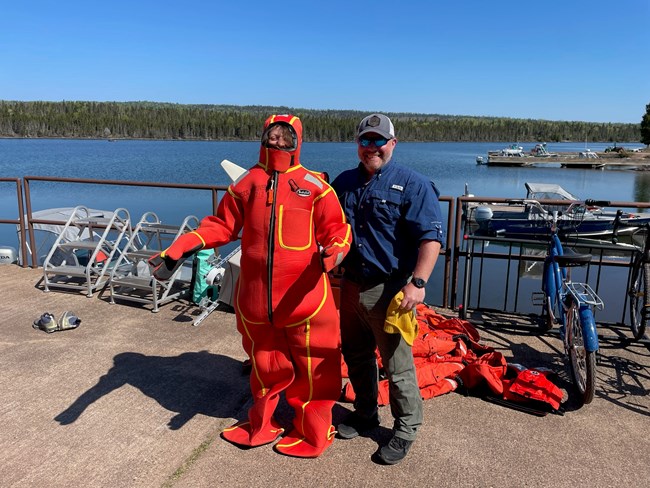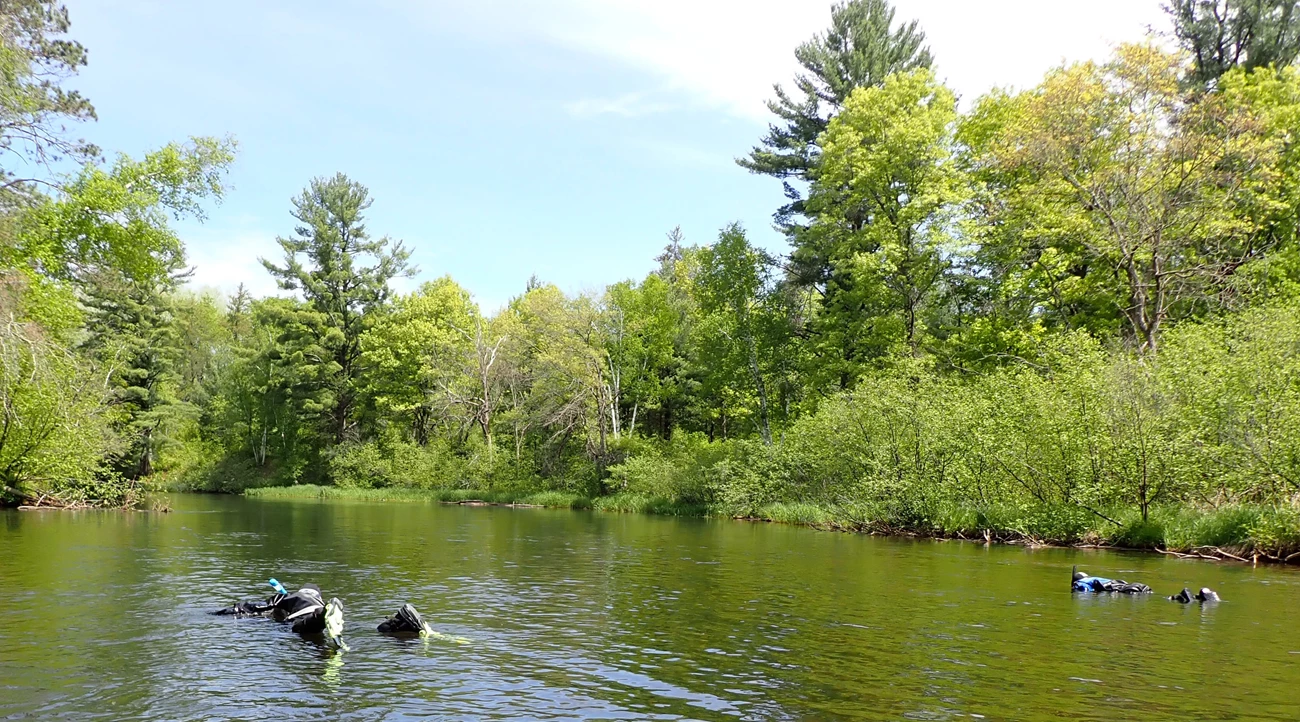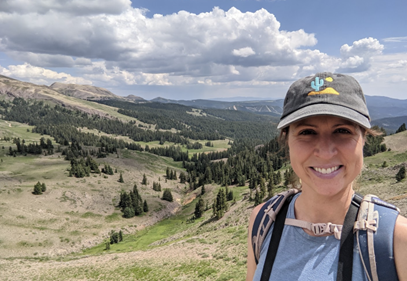Last updated: August 1, 2025
Article
The Current, Spring/Summer 2025
Adjusting to the Times
By Ted Gostomski, Network Science Writer
This content has been updated from a previous version.
The first half of 2025 has presented new priorities and some uncertainty, creating a few challenges for our network’s Inventory and Monitoring program. One of the challenges has been a lack of capacity due to the departure of staff in our program, in parks, and regional offices through early retirements, deferred resignations, voluntary separations, and consolidation out of the National Park Service and into the Department of the Interior. Here in Ashland, this includes IT Specialist Kelly Garrison and I&M Regional Program Manager Shauna Marquardt, and from our shared office space Midwest Fisheries Biologist Jay Glase and an intern.With a wide range of uncertainty around changes to federal administrative processes as well as the federal workforce, planning and preparation for the field season was effectively paused or delayed, and by late May we appeared to have enough of a footing to proceed with field work on a limited basis.
With a wide range of uncertainty around changes to federal administrative processes as well as the federal workforce, planning and preparation for the field season was effectively paused or delayed, and by late May we appeared to have enough of a footing to proceed with field work on a limited basis.

NPS photo
Adapting to Our Situation
The vegetation monitoring crew is at Grand Portage National Monument (GRPO) this year, a smaller park that requires ecologist Jessica Kirschbaum to hire two seasonal crew members. Fortunately, one of those people is nine-year vegetation monitoring veteran, Erin Blow. While this is Erin’s first season in GRPO, she has been with the monitoring crew at every other park in the network. Having an experienced crew member like Erin gives Jessica flexibility to meet this season’s project needs.
Landbird monitoring is completed each June by a team of park staff, volunteers, and contractors, but due to attrition and new operational constraints, not everything will be completed this year. Retirements this spring limited the resource management staff at Apostle Islands, yet workload at the park has not decreased commensurate to staffing, so with time and boat fuel at a premium, landbird monitoring is unlikely to proceed as it has in the past.
Similarly, inland lakes water quality monitoring has begun at most parks, but changes at Indiana Dunes National Park have forced the park to reprioritize water quality sampling projects. The first round of water quality sampling on the St. Croix National Scenic Riverway (SACN) was delayed and one round of data was lost, but Rick Damstra has since been able to resume sampling.
Amphibian monitoring and collection of dragonfly larvae for mercury contamination monitoring will continue at all nine parks.
Looking Ahead
Travel and operations are slowly resuming for critical field work and continuity planning and knowledge transfer work is underway to make it easier for monitoring programs to continue with reduced staff. We also have compiled a list of Data Store links for each program for parks so that more staff are able to easily access our datasets.
Along with transferring knowledge, we prepared transfer paperwork to quickly transfer property should it become necessary. We continue to provide funding to support monitoring projects led by partners and cooperators in conjunction with park staff. Landscape dynamics, dragonfly larvae collection for contaminants monitoring, and even our forest vegetation monitoring are funded through the rest of the fiscal year.

NPS photo / A. Egan
Finding Joy Amid the Chaos
Kudos to all our network staff for continuing to do good work and advance science in the field. In March, network staff took our show on the road to a community open house hosted by the Mashkiiziibii (Bad River) Natural Resources Department. Along with the usual hand-outs, we brought along examples of sampling equipment and a “sound show” of things captured in the field by our remote amphibian recorders.
In May, network staff served as canoe and kayak paddlers in support of a native mussel inventory that SACN and a university partner are conducting on all 100 miles of the Namekagon River. Also, data manager Cyrus Hester and wildlife biologist Jessica Joganic traveled to Isle Royale to participate in the Motorboat Operator Certification Course.
Aquatic ecologist David VanderMeulen and Dragonfly Mercury Project collaborators at the U.S. Geological Survey and NPS Air Resources Division have begun a study to model spatial and temporal drivers of mercury risk in the Great Lakes Network parks. In addition to our dragonfly mercury data, the study will also make use of our long-term water quality data to identify relationships between water chemistry and landscape characteristics with mercury concentrations measured in dragonflies collected at GLKN parks. Ultimately, they hope to predict mercury contamination risk to fish, wildlife, and human health in park lakes.
No one knows for sure what’s ahead for IMD or the NPS, and a weariness has set in from being in a persistent reactive state to the uncertainty. For now, we have done everything we can to prepare our program and ourselves for whatever may come.

Photo by Mark Hove / University of Minnesota

J. Joganic
Wildlife Biologist Position Added to Great Lakes Network
The network has talked for years about creating a wildlife biologist position that could take on at least two monitoring programs being overseen by others and always as a collateral duty: amphibians and bats. Landbirds was also considered in that set, but finding someone with skills in all those areas was a long shot. Even though our amphibian and bat monitoring rely on acoustic recordings, making technological proficiency the more important skill set, there is still a need for understanding the ecology of the wildlife species. There were also questions of cost and whether or not we could or should add a new position to our organizational chart. But when a new job took our long-time assistant data manager to the Fish and Wildlife Service, it was decided to change that box in our organization chart from assistant data manager to wildlife biologist.
In December, Jessica Joganic became the network’s first wildlife biologist. Originally from Phoenix, Jess holds a bachelor’s degree in anthropology from Arizona State University and a PhD in biological anthropology from Washington University in St. Louis, Missouri. She conducted postdoctoral research at the University of Bordeaux in Paris, completing various projects on cranial growth and variation in humans and other primates. After deciding to switch fields, Jess earned an Master’s degree in wildlife biology and conservation from Edinburgh Napier University in Scotland, where she studied the impact of stream restoration efforts on floodplain invertebrate communities.
Jess has broad research interests across both terrestrial and aquatic systems, but particularly loves landscape ecology questions and studying birds. She has studied vervets in South Africa, baboons in Zambia, frog camouflage in Costa Rica, birds and forestry on the Olympic Peninsula, and fish with the U.S. Geological Survey at Cuyahoga Valley National Park in Ohio. In other fields of study, she assisted with a study of Eocene mammals in Wyoming’s Big Horn Basin and research on the Buddhist diaspora in India and Tibet.
Jess started her career in the NPS as a Scientists-in-Parks (SIP) intern working with native freshwater mussels in the Midwest Region, then moved into a seasonal ecologist position at Buffalo National River in Arkansas planning for early detection of aquatic invasive species.
Moving to Ashland from Missouri in the midst of a more traditional Great Lakes winter, there was some requisite acclimation to the challenges of snow and ice. She handled it all very well and is now settled in and charging ahead. Welcome, Jess!
2025 Field Season Schedule
This schedule was prepared before changes in the federal workforce and specifically among our parks changed some priorities.
| Park | Amphibians | Contaminants-Dragonflies | Landbirds | Vegetation | Water Quality |
|---|---|---|---|---|---|
| Apostle Islands | Mar-Aug | June-Oct | June | n/a | n/a |
| Grand Portage | Mar-Aug | June-Oct | June | June-Aug | n/a |
| Indiana Dunes | Mar-Aug | June-Oct | June | n/a | May, Jul, Sept |
| Isle Royale | Mar-Aug | June-Oct | June | n/a | May-Sept (2) |
| Mississippi River | Mar-Aug | June-Oct | June | n/a | n/a |
| Pictured Rocks | Mar-Aug | June-Oct | June | n/a | June-Sept |
| St. Croix Riverway | n/a (1) | June-Oct | June | n/a | Apr-Nov (3) |
| Sleeping Bear Dunes | Mar-Aug | June-Oct | June | n/a | June-Sept |
| Voyageurs | n/a (1) | June-Oct | June | n/a | June-Sept (4) |
Amphibians — Network, park, or tribal staff will visit each site between 1 August and late September to collect SD cards, service the song meters as needed, and prepare them for the following spring.
Contaminants-Dragonflies — Samples will be collected by a contractor at APIS, GRPO, ISRO, and SACN, and by park staff and volunteers at the other parks.
Landbirds — Surveys are conducted by park staff, volunteers, and contractors.
Vegetation — Conducted with a team of two cooperators led by Jessica Kirschbaum.
Water Quality — Conducted by Alex Egan (ISRO), Tony Vitale (PIRO), Rick Damstra (SACN), Chris Otto (SLBE), and James Smith (VOYA).
(1) Monitoring is conducted using a U.S. Geological Survey protocol.
(2) Includes assisting with nearshore water quality monitoring on Lake Superior.
(3) Monthly sampling generally first full week of each month April–November with additional invertebrate sampling July–August.
(4) Includes sampling for mercury in water from a subset of lakes.

NPS photo
Working Together
In May, the network and the Grand Portage Band Trust Lands Agency (Trust Lands) reached an agreement to collaborate on amphibian monitoring at Grand Portage National Monument, which resides entirely within the exterior boundaries of the Grand Portage Reservation. Trust Lands staff will maintain the songmeters at long-term monitoring locations along the old portage trail and send data collected at those sites to GLKN for processing and publication. GLKN will provide troubleshooting assistance and annual resupplies. GLKN will also share results and work with Trust Lands staff to interpret findings.
This is the network’s first cooperative monitoring agreement with a tribal entity.

Cover photo © Prufrock Press
Five Minutes of Fame
A glimpse into the world of bird biology through the work of network biologist, Ted Gostomski, is part of a new book for elementary and middle schoolers called Real World Math (Prufrock Press, 2025). Written by a former teacher and local author, Marya Washington Tyler, the book “bring[s] math to life with 200 real-world problems encountered in 20 fascinating careers.”
Real World Math shows how people use math every day. Ted’s profile includes a brief summary of how we conduct songbird surveys then poses eight questions for students to solve including “what time do I want to arrive [at the first bird survey point if I have to be there half-hour before sunrise, the sun rises at this time, and it takes this much time to get ready and travel to the site]?” Then, after looking over a table of data from surveys at one park, students are asked to calculate the ratio of frugivore (fruit-eating) bird species to omnivore species.
“It’s the kind of book I wish I had when I was younger,” says Ted. “I have struggled with math my entire life. My parents sent me to summer school when I was in second or third grade to help me improve my math skills, and they were kind of stunned when I changed my college major to biology because science requires math. My mom will be so proud of this.”
New Reports, Publications, and Data Packages
All of these reports and data packages can be found on the Great Lakes Network website: www.nps.gov/im/glkn/reports-publications.htm or by using the DOI (digital object identifier). Great Lakes Network staff are indicated in bold blue text.
Burner, R.C., A.A. Kirschbaum, T. Gostomski, and D.G. Peitz. 2025. US national park units as breeding bird habitat: A comparison of species prevalence and land cover across the midwestern and central United States. Science Report NPS/SR—2025/317. National Park Service, Fort Collins, Colorado. https://doi.org/10.36967/231260.
Damstra, R.A., and C.M. Hester. 2025. Saint Croix National Scenic Riverway invertebrate data package by the Great Lakes Inventory and Monitoring Network. National Park Service, Fort Collins, Colorado. https://doi.org/10.57830/2313034.
Damstra, R., and D. VanderMeulen. 2025. Great Lakes Network 2006–2024 large rivers water quality monitoring data as of 2025-03-15. National Park Service, Fort Collins, Colorado. https://doi.org/10.57830/2309369.
Egan, A., and D. VanderMeulen. 2025. Great Lakes Network 2006–2024 inland lakes water quality monitoring data as of 2025-03-21. National Park Service, Fort Collins, Colorado. https://doi.org/10.57830/2309514.
Gostomski, T., and C.M. Hester. 2025. Great Lakes landbird monitoring data package by the Great Lakes Inventory and Monitoring Network. National Park Service, Fort Collins, Colorado. https://doi.org/10.57830/2312784.
Sanders, S., and J. Kirschbaum. 2024. Forest vegetation monitoring protocol (version 2.1): Great Lakes Inventory and Monitoring Network. Science Report NPS/SR—2024/166. National Park Service, Fort Collins, Colorado. https://doi.org/10.36967/2305281.
Stottlemyer, R., S.J. Tassone, and C.M. Hester. 2025. Long-term water quality conditions in sentinel streams at Isle Royale National Park and Grand Portage National Monument. National Park Service, Fort Collins, Colorado. https://doi.org/10.57830/2311531.

Brenda Larancois
Editor and Web Manager
Ted Gostomski
Thanks to the following contributors
Cyrus Hester
Jessica Joganic
Brenda Lafrancois
Tags
- apostle islands national lakeshore
- grand portage national monument
- indiana dunes national park
- isle royale national park
- mississippi national river & recreation area
- pictured rocks national lakeshore
- saint croix national scenic riverway
- sleeping bear dunes national lakeshore
- voyageurs national park
- apostle islands national lakeshore
- grand portage national monument
- indiana dunes national park
- isle royale national park
- mississippi national river and recreation area
- pictured rocks national lakeshore
- saint croix national scenic riverway
- sleeping bear dunes national lakeshore
- voyageurs national park
- inventory and monitoring division
- newsletter
- great lakes network
